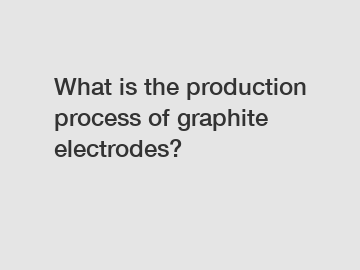What is the production process of graphite electrodes?
Graphite electrodes are a critical component widely used in various industries, particularly in the steel and aluminum sectors, where they play a pivotal role in electric arc furnaces (EAFs). These seemingly unassuming rods, crafted through a complex production process, possess high thermal conductivity and electrical resistance, enabling them to withstand extreme temperatures and deliver efficient power conduction. In this blog, we will embark on a journey into the world of graphite electrode manufacturing, uncovering the intricacies, advancements, and significance of this production process.
1. Understanding the Raw Material:
The production process of graphite electrodes begins with their primary ingredient: high-quality petroleum coke. This green coke is obtained either from delayed coking units or fluid cokers that convert heavy oil into lighter hydrocarbon products. Petroleum coke with a low sulfur and metals content is preferred for producing high-performance graphite electrodes.

2. Coke Calcination:
To transform petroleum coke into a suitable raw material for electrode production, it undergoes a rigorous calcination process. Calcination involves subjecting the coke to extreme temperatures of approximately 1300 to 1400 degrees Celsius in a rotary kiln. This process eliminates volatile matter and impurities, resulting in high-purity calcined petroleum coke (CPC).
3. Mixing the Ingredients:
Once the coke is calcined, it is mixed with coal tar pitch (CTP), a binder material that imparts strength and coherence to the electrodes. The calculated combination of CPC and CTP is critical to achieving optimal quality and performance characteristics in the final product. This mixture is carefully blended to ensure uniformity and homogeneity.
4. Extrusion and Forming:
The blended CPC and CTP mixture is then fed into an extruder, which applies immense pressure to shape it into long cylindrical rods. This extrusion process ensures the formation of an interconnected network of graphite grains, enhancing the electrode's mechanical strength and electrical conductivity. The extruded rods are then cut into specific lengths and cooled.
5. Baking the Electrodes:
Additional reading:Which Innovative Designs Are Transforming Structural Steel?
What is Mullite Sand used for?
What color is satin bronze?
The Ultimate Guide To Woven Wire Mesh Filters
How do I choose a bbq grill net?
The Ultimate Guide to High Conductivity Graphite Electrodes: Unraveling Google's Top Queries!
When did neodymium magnets come out?
Next comes the baking process, where the extruded rods are placed in a specialized baking furnace at temperatures exceeding 2,000 degrees Celsius. This step removes any remaining volatile materials, drives out water vapor, and further purifies the structure of the electrodes. The baking process is critical as it significantly influences the final properties of the graphite electrode.
6. Graphitization:
After baking, the graphite rods undergo a transformation known as graphitization. The rods are subjected to even higher temperatures, reaching around 3,000 degrees Celsius in an environment devoid of oxygen, ensuring the carbon structure rearranges into a highly ordered lattice. This critical step enhances the electrical conductivity and thermal stability of the electrode, making it suitable for the demanding environments of electric arc furnaces.
7. Machining and Quality Control:
Once graphitized, the graphite electrodes undergo precise machining to achieve the desired shape, dimensions, and surface finish. Advanced CNC machines are utilized to create the necessary modifications, ensuring consistency and accuracy. Quality control procedures, including dimensional checks, surface inspections, and mechanical tests, are carried out at various stages to ensure compliance with stringent industry standards.
8. Coating and Packaging:
To enhance the performance and extend the service life of graphite electrodes, a specialized coating is applied. Anti-oxidation coatings such as petroleum-based or synthetic resins are employed to protect the electrodes from excessive oxidation and to prevent breakage during operation. Finally, the finished electrodes are packaged and prepared for transportation to industries around the globe.
Conclusion:
The production process of graphite electrodes exemplifies the epitome of human ingenuity and technological advancement. From the initial acquisition of raw materials to the final coating, each step is meticulously designed to produce electrodes capable of withstanding extreme conditions in electric arc furnaces. Through continuous research and development, manufacturers strive to improve the quality, performance, and longevity of these unsung heroes of industrial innovation. Graphite electrodes may seem inconspicuous, but their impact on modern industries cannot be overstated.
If you want to learn more, please visit our website 500mm UHP Graphite Electrode Features, 500mm UHP Graphite Electrode Features, 500mm UHP Graphite Electrode Features.
Additional reading:Unraveling the Mysteries of Cemented Carbide Rods: All You Need to Know About Dimension Variations
Which Industries Are Embracing Square Hole Perforated Metal for Innovative Designs?
What is pipe class K12?
The Ultimate Guide to API K55 Tubing
Which are the top 10 pig wire panel designs for optimum durability and affordability?
What are graphite blocks used for?
The Ultimate Guide to Hot Rolled Steel Wire Rods
164
0
0
Related Articles
-
189
0
0
-
What are the advantages of Epoxy Coated Stainless Steel Wire Mesh for B2B buyers?
What are the advantages of Epoxy Coated Stainless Steel Wire Mesh for B2B buyers?
174
0
0
-
156
0
0
-
171
0
0
-
178
0
0
-
Graphite petroleum coke: Unlocking its diverse applications and sustainability
Graphite petroleum coke: Unlocking its diverse applications and sustainability.
181
0
0
-
161
0
0
-
198
0
0










Comments
All Comments (0)